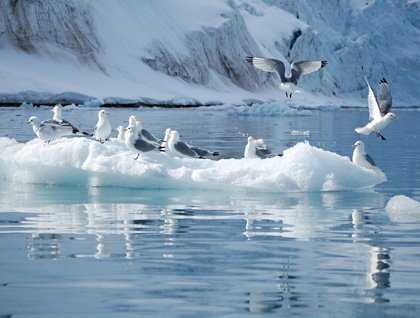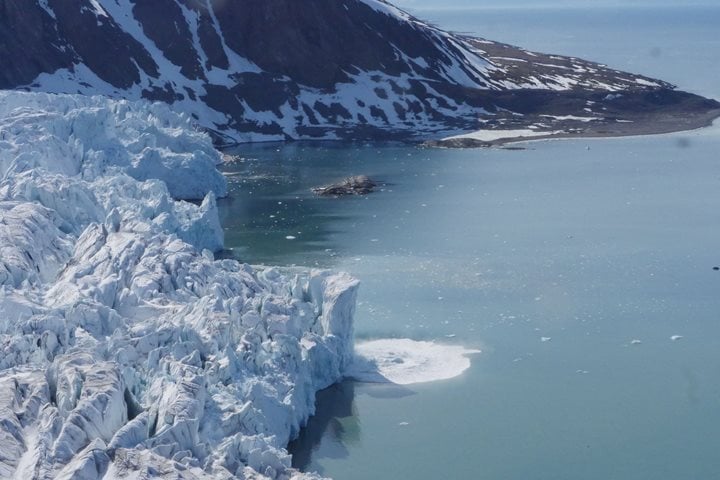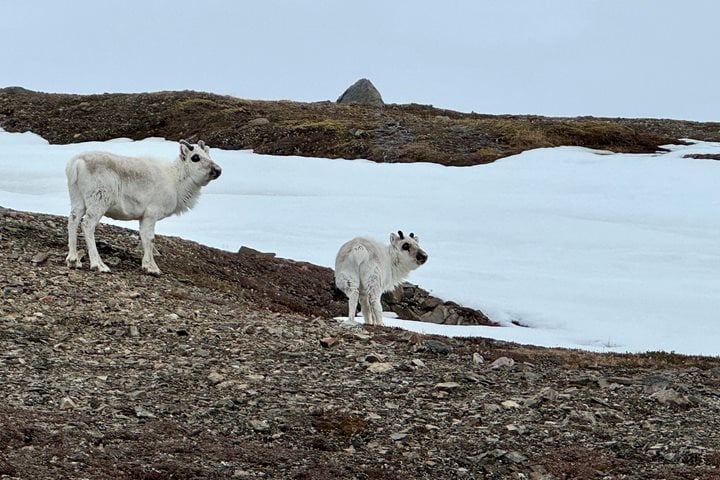“Good morning, good morning,” expedition leader Lucho said at 6:30 a.m. as the ship pulled up to Moffen Island. This is a protected area with a lagoon at its center. Interesting artifacts, like figureheads from old ships, wash up on its shore. Guests had a wonderful view of a walrus herd sunning on the shore. Moffen Island, at 80° 00’N 14° 30’ E, is a common walrus haul-out. As the largest of the pinniped family, walruses do not have any natural predators. After the brief stop to observe and photograph these amazing creatures, we ventured on to Hamiltonbukta (bukta meaning bay) in the Roaudfjorden for Zodiac cruises. All around Hamiltonbreen (breen meaning glacier) the Zodiacs gave guests spectacular views of small glacial calving events, beautiful cliff views, reindeer, a kittiwake colony of thousands dotting the cliffs, and some even witnessed a curious bearded seal.
Like any expedition, the plans changed and National Geographic Explorer made its way to Fuglefjorden during lunch. At 16:00 guests were given the opportunity for more Zodiac rides and kayaking in Fuglefjorden around Svitjdbreen. Many took advantage of the photo opportunities as dappled light shone through the clouds and onto the snow and ice.
As the ship headed for the evening location, many reflected on their afternoon excursions. David Cummings gave a thoughtful perspective on sea kayaking saying, “This is nature at its purest—how the explorers first saw it. This Lindblad Expedition makes us appreciate how tremendously precious natural beauty is. It’s mystical and profound.”
George Chandler caught himself, “hanging his head over the bow just observing sea ice in awe,” as inspired by naturalist Eric Guth’s lessons on ice vocabulary and formation. We’re all ‘pagophiles’ now (pagos is greek for ice or frost).
Finally, Jeff Chaddock reported that on his Zodiac ride, as the glacier calved, he heard a “loud and brilliant noise. From far away the glacier looked small. Up close, the Zodiac gave a scale of its large size.”
Infamous Polar Bear Plunge time! As kayakers were making their way back to the ship, the most adventurous amongst us prepared to jump into the Arctic Ocean. With music to hype up the brave swimmers, the atmosphere in the mudroom was that of excitement and anticipation. Diving into 0 degree sea gave us a connection to the morning walrus sighting. While the walrus was trying to cool off on this 3°C day, we instantly realized we couldn’t stand more than a few seconds in the water. With its five inches of blubber, the walrus is clearly more adapted to this environment than us!
Following the plunge, naturalist Dennis Cornejo talked about the ROV (remote operated vehicle) deployment and the plankton tow with the National Geographic Grosvenor Teacher fellows who collected data and pictures. Through a microscope he showed examples of the copepods collected during the day’s expedition. Copepods are a shrimp relative, the most numerous animal in the world—certainly in the ocean. Copepods can be considered the ‘cows of the sea’ as they graze on algae as cows graze on grass. Naturalist Jenny Kingsley explained the ‘Meet the North’ project and naturalist Keith Larson ‘Defined the Arctic,’ connecting the past to the present glacial conditions in the far north.
Videographer Mark Cogner, emotionally attached us all to our Arctic experience through a preview of the expedition video—a remarkable souvenir to capture footage of the voyage. The evening concluded with National Geographic representative, Kent Kobersten, sharing photo essays with National Geographic photographers telling the captivating stories behind their photography.
Something about the Arctic speaks to its visitors, as Dan Amatuzzo feels “an inspiration to do something to help the Earth. While in the vast Arctic, we see that we are only a small part of the Earth.”
“If you’re not trying to change the world, what’s the point? The only way to change the world is to connect people.”
– naturalist Keith Larson






